UNIT 6: CELL AND NUCLEAR DIVISION
Key unit competence
Describe the stages of the cell cycle and explain the significance
of cell and nuclear division in organisms.
Introductory Activity
Analyze the figure of the house built in bricks below. The bricks came from
the valley where they are made, and then have been used to build this
house.
1. Is it possible to build a house like this by using only one brick?
2. Explain what happened for this house to be built at this level?
3. Link the analogous example of building a house by using bricks
with growth of and increasing in size of a human body from the
body size of a one day new baby to the body size of adult person.
4. Is it possible for the body of an adult person to be made by only
one cell?
5. Where are cells which make the adult human body come from?
6. How are they produced?
6.1. Cell cycle
Activity 6.1
Visit your smart classroom/library using search engine or textbooks and
discuss more information about the main phases of the cell cycle and
present them on manila paper.
The cell cycle is a series of events of cellular growth and division that has
five phases such as:
– The first growth phase (G1),
– The synthesis phase (S),
– The second growth phase (G2),
– Mitosis (M),
– Cytokinesis.
The three first phases (G1, S, and G2) of the cell cycle collectively are knownas interphase (the phase between two mitotic divisions).
During the cell cycle, the cell grows, grows its DNA and divides into two daughter cells.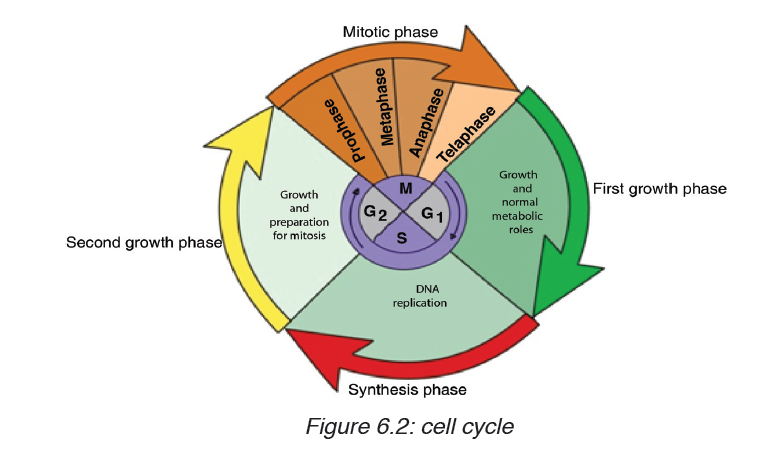
6.1.1. The first growth phase (G1)
During this phase, a cell undergoes rapid growth and the cell performs its
routine functions. The cell spends most of its life in the G1 phase. If the cell
is not dividing, it remains in this phase. The time taken for the completion of
G1 phase varies among species and the type of cells. But on an average, it
takes around 11 hours for the completion of this phase.
6.1.2. The synthesis phase (S)
DNA synthesis or DNA replication takes place in this phase. The S phase
takes around 8 hours to complete.
6.1.3. The second growth phase (G2)
It is the short period, in which the cell continues to grow, making proteins
and manufacturing many organelles necessary for cell division. This phase
serves as an intermediate between the synthesis phase and the mitotic
phase. It takes around four hours to complete
6.1.4. Mitosis
This is the phase of nuclear division in which one nucleus divides through
four phases (prophase, metaphase, anaphase and telophase) and becomes
two nuclei.
6.1.5. Cytokinesis
In this phase, the cytoplasm divides in half, producing two daughter cells,each containing a complete set of genetic material.
Application activity 6.1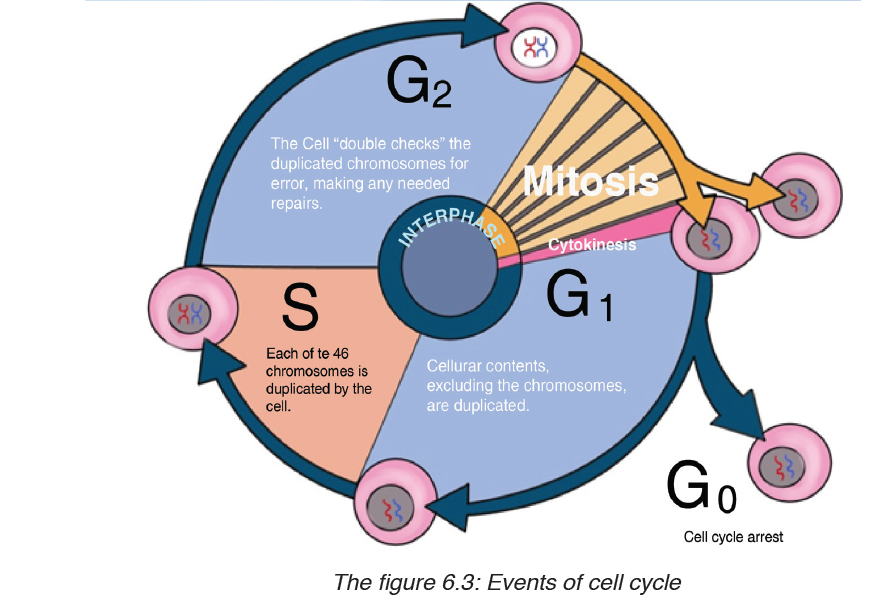
1. What do you understand by the cell cycle?
2. Describe all phases of the cell cycle.
3. Predict what may happen if the cytokinesis does not take place in
the succession of cell cycle.
6. 2. Mitosis and meiosis: stages and results
Activity 6.2
Using your knowledge from ordinary level, textbooks internet, discuss and
present the phases of mitosis and meiosis on manila papers.
6.2.1. Mitosis
Mitosis is a type of cell division that produces two daughter cells having the
same number and kind of chromosomes as the mother cell. It takes place
only in eukaryotes, where the nuclear division (karyokinesis) occurs. This
phase takes around 1 hour to complete. The mitotic cell division is more
rapid at the meristematic region of plant and root tip as it is the growing
region of the plant. The mitotic phase is divided into four steps that includeProphase, Metaphase, Anaphase and Telophase.
6.2.1.1. Prophase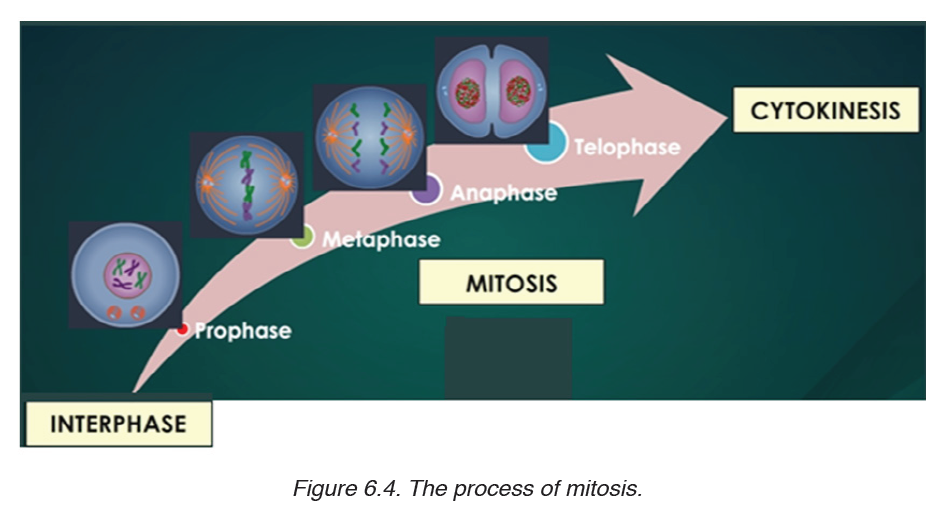
Prophase is the first and longest phase of mitosis. During prophase:
– The DNA and histone proteins coils up into visible chromosomes, each
made up of two sister chromatids held together by the centromere.
– The nucleus disappears as the nuclear envelope and nucleolus break apart.
– The centrioles begin to move to opposite ends, or poles, of the cell.
– As the centrioles migrate, the fiber-like spindle begins to elongate
between the centrioles. In plant cells, the spindle forms without
centrioles. The spindle plays an essential role moving chromosomesand in the separation of sister chromatids.
6.2.1.2. Metaphase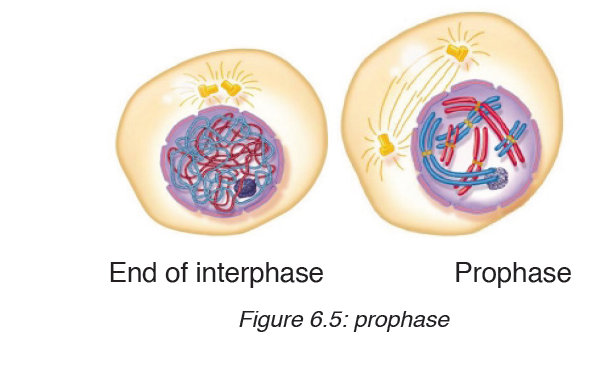
During metaphase, the spindle which attaches to the centromere of each
chromosome helps the chromosomes to line up at the center of the cell by
forming the equatorial plate also known as the metaphase plate. Each sister
chromatid is attached to a separate spindle fiber, with one fiber extending toone pole, and the other fiber extending to the other pole.
6.2.1.3. Anaphase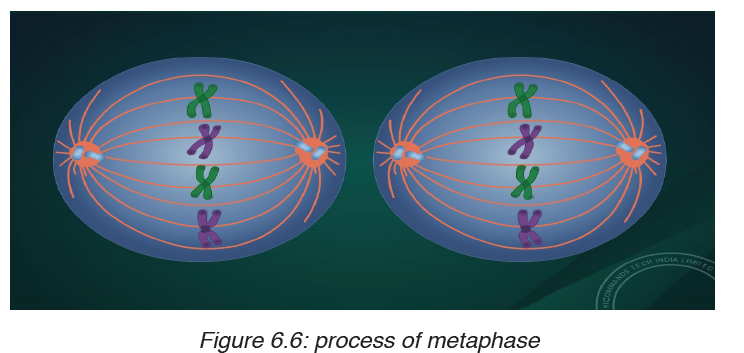
During Anaphase:
– Centromeres divide,
– The sister chromatids separate and pulled apart by the shortening of
the spindles,
– One sister chromatid moves to one pole of the cell, and the other sister
chromatid moves to the opposite pole, (sister chromatids take the name
of chromosomes as soon as they separate).
– At the end of anaphase, each pole of the cell has a complete set of
chromosomes, identical to the amount of DNA at the beginning of G1of the cell cycle.
6.2.1.4. Telophase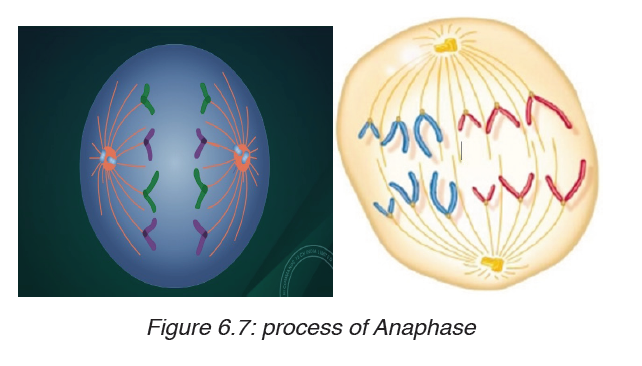
During telophase which is the opposite of prophase:
– The spindle disappears,
– Formation of two nuclei,– The nuclear envelopes surround the two nuclei.
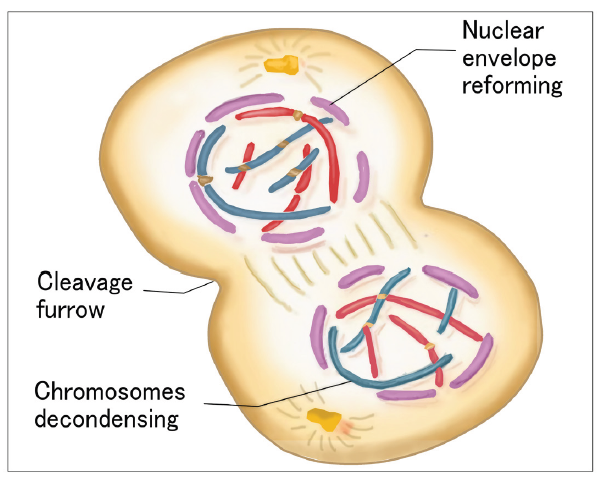
Cytokinesis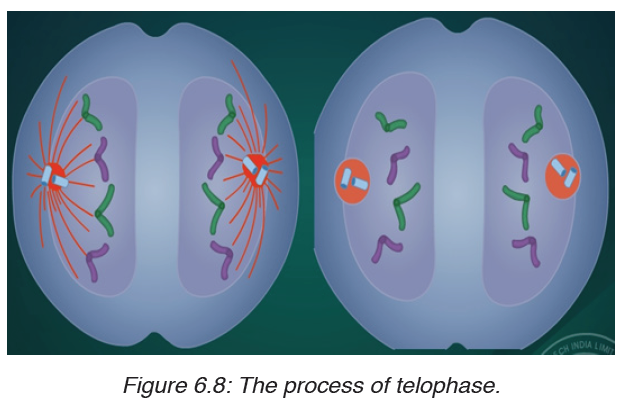
During this phase, the cytoplasm divides in half, producing two daughtercells, each containing a complete set of genetic material as the mother cell.
Table 6.1: A table showing phases of cell cycle with one important event at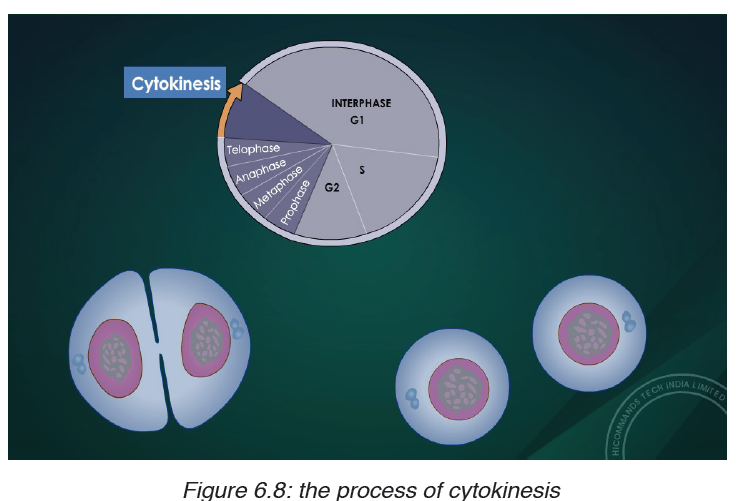
each phase
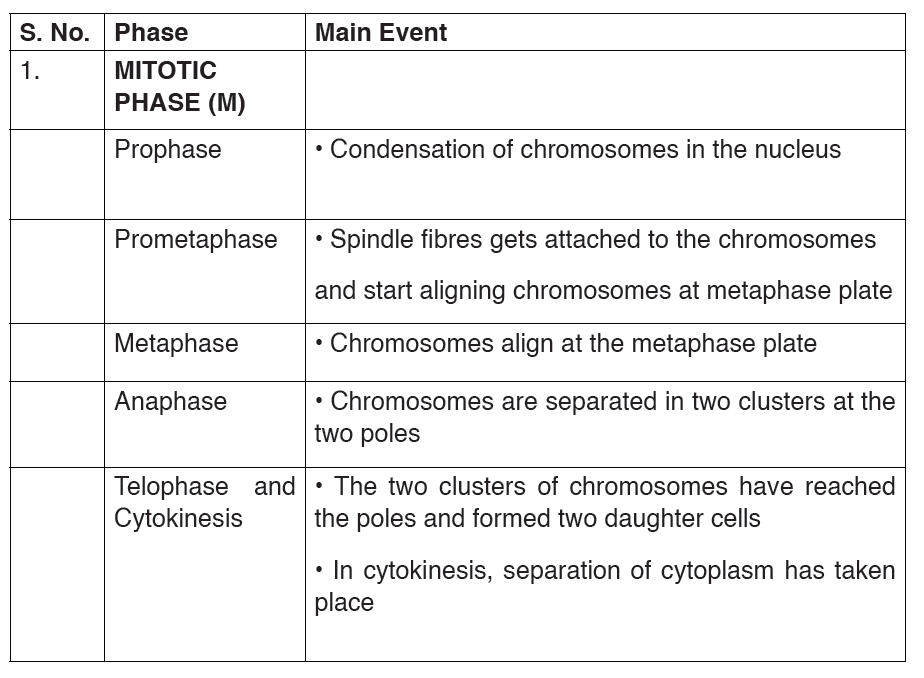
6.2.2 Meiosis
In sexual reproduction, meiosis produces haploid gametes that fuse together
during fertilization to produce a diploid zygote. Meiosis involves two divisions
without an interphase in between, starting with one diploid cell and generating
four haploid cells. Each division, named meiosis I and meiosis II, has fourstages: prophase, metaphase, anaphase, and telophase.
During meiosis the number of chromosomes is reduced from a diploid number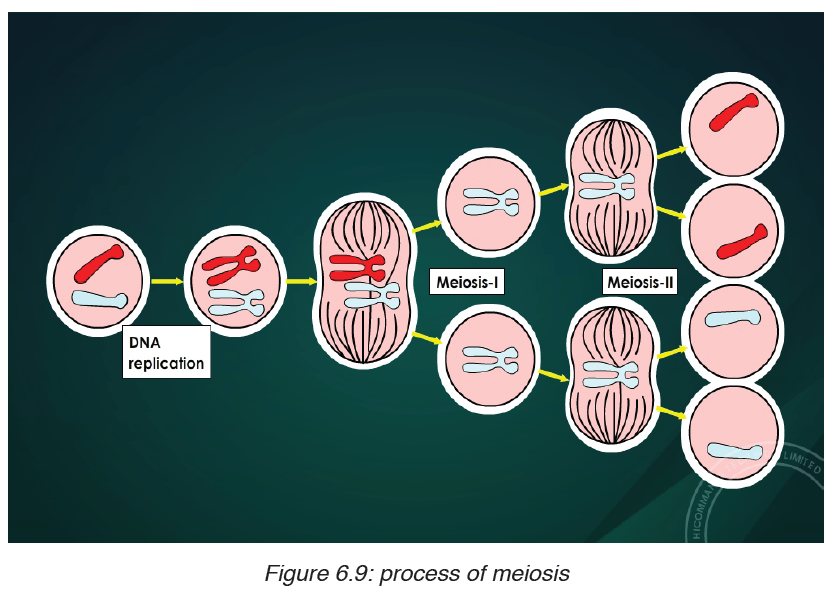
(2n) to a haploid number. During fertilization, haploid gametes come
together to form a diploid zygote, and the original number of chromosomes
(2n) is restored.
8 Stages of meiosis are summarized below:
Prophase I: Prophase I is very similar to prophase of mitosis, but with one
very significant difference. In prophase I, the nuclear envelope breaks down, the chromosomes condense, and the centrioles begin to migrate to opposite
poles of the cell, with the spindle fibers growing between them.
During this time, the homologous chromosomes form pairs. These
homologous chromosomes line up gene-for-gene down their entire length,
allowing the crossing-over to occur.
This process permits the exchange of genetic material between maternal
and paternal chromosomes. Thus, crossing-over results in genetic
recombination by producing a new mixture of genetic material. This is an
important step in creating genetic variation.
Metaphase I: In metaphase I, the 23 pairs of homologous chromosomes
line up along the equator of the cell.
Anaphase I: During anaphase I the spindle fibres shorten, and the
homologous chromosome pairs are separated from each other. One
chromosome from each pair moves toward one pole, with the other moving
toward the other pole, resulting in a nucleus with 23 chromosomes at one
pole and the other 23 at the other pole. The sister chromatids remain attached
at the centromere.
Telophase I: The spindle fibres disappear and the nucleus reforms. This is
quickly followed by cytokinesis and the formation of two haploid cells, each
with a unique combination of chromosomes, some from the father and the
rest from the mother.
After cytokinesis, both cells immediately enter meiosis II, without replication
of the DNA. Meiosis I is described as reductional division as it reduces by
half the number of chromosomes of the mother cell. Meiosis II is equational
division, and it occurs like a normal mitosis, separating the sister chromatids
from each other.
Prophase II: Once again the nuclear membrane breaks down, and the
spindle begins to reform as the centrioles move to opposite sides of the cell.
Metaphase II: The 23 chromosomes, each made out of two sister chromatids,
occupy the equator of the cell.
Anaphase II: The centromere divides and sister chromatids are separated
and move to opposite poles of the cell. As the chromatids separate, each is
known as a chromosome. Anaphase II results in a cell with 23 chromosomes
at each end of the cell; each chromosome contains half as much genetic
material as at the start of anaphase II.
Telophase II: The nucleus reforms and the spindle fibers break down. Each
cell undergoes cytokinesis, producing four haploid cells, each with a uniquecombination of genes and chromosomes.
Comparison of Mitosis and Meiosis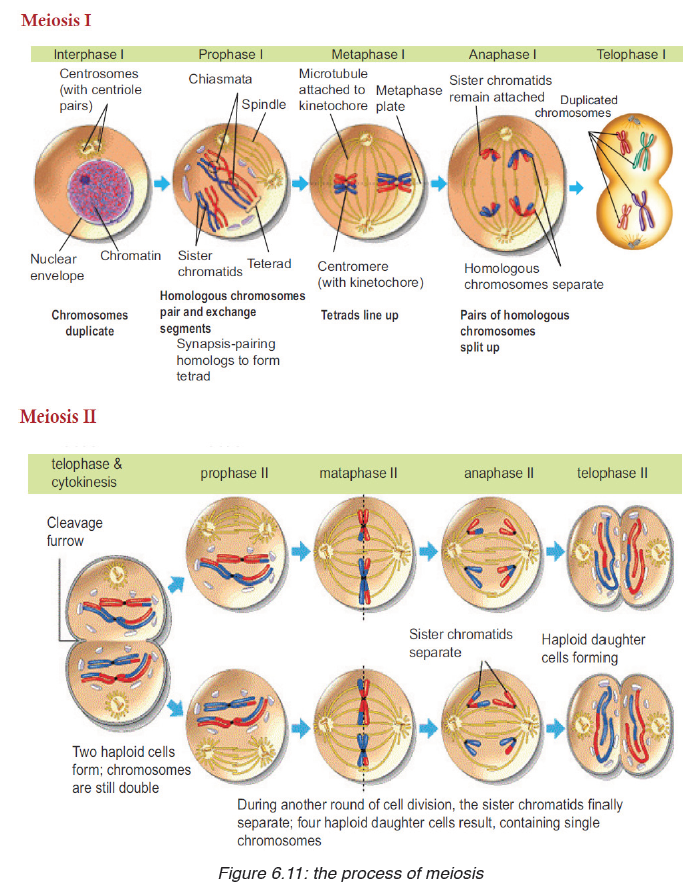
Table 6.2: Comparison between mitosis and meiosis
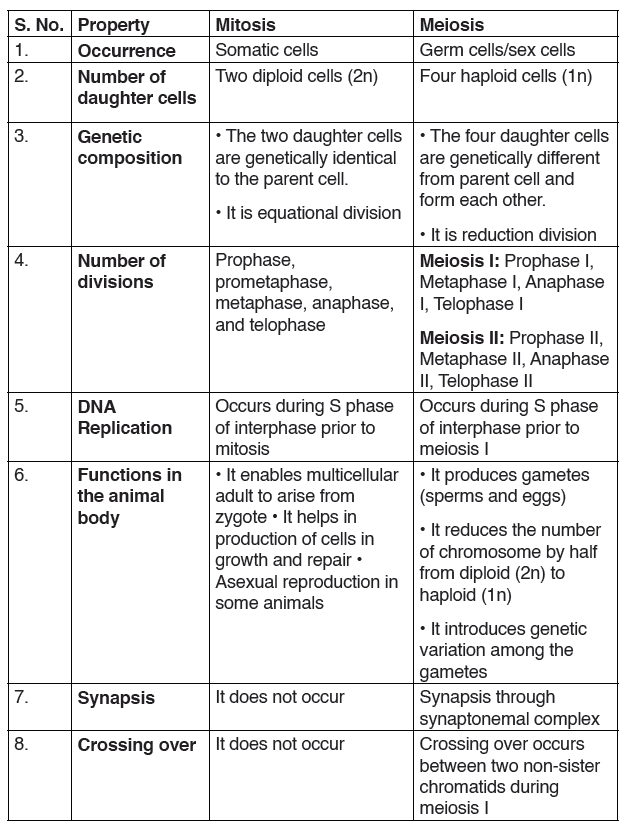
Haploid and diploid conditions of the cell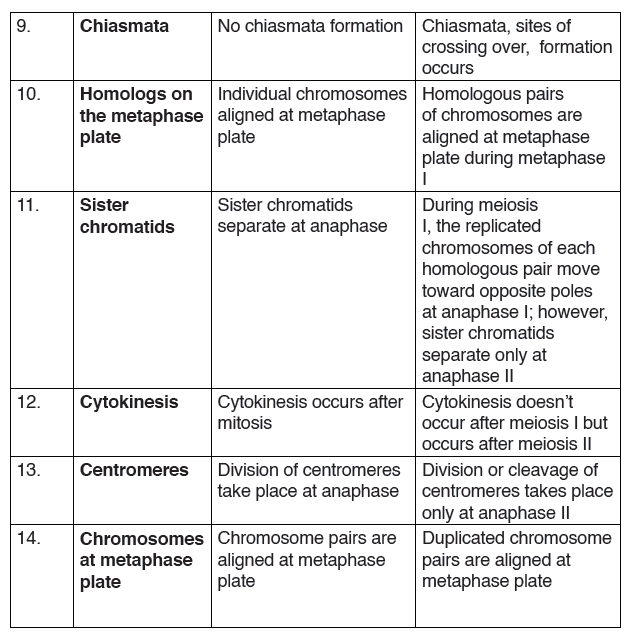
During the formation of gametes,the number ofchromosomes is reduced
by half, and returned to the full amount when the two gametes fuse during
fertilization. The cells of human beings, most animals and many plants
(except for their gametes) are diploid abbreviated as 2n. They contain two
sets of chromosomes in their nuclei. The haploid cells have only one set of
chromosomes, abbreviated as n. Ploidy is a term referring to the number of
sets of chromosomes.
Organisms with more than two sets of chromosomes are termed polyploid.
Chromosomes that carry the same genes are termed homologous
chromosomes.Meiosis is a special type of nuclear division which segregates
one copy of each homologous chromosome into each new “gamete”. Mitosis maintains the cell’s original ploidy level (for example, one diploid 2n cell
producing two diploid 2n cells; one haploid n cell producing two haploid
n cells; etc.). Meiosis, on the other hand, reduces the number of sets of
chromosomes by half, so that when gametic recombination fertilizationoccurs
the ploidy of the parents will be re-established.
Two successive nuclear divisions occur, Meiosis I (Reduction) and Meiosis II
(Division). Meiosis produces 4 haploid cells. Mitosis produces 2 diploid cells.
The old name for meiosis was reduction/ division. Meiosis I reduces the
ploidy level from 2n to n (reduction) while Meiosis II divides the remaining set
of chromosomes in a mitosis-like process (division). Most of the differences
between the processes occur during Meiosis I.
Application activity 6.2
1. Give two reasons why cells divide.
2. As a cell increases in size, which increases more rapidly, its surface
area or its volume?
3. Describe what happens during each of the four phases of mitosis.
4. Describe what happens during interphase.
5. How is cytokinesis in plant cells similar to cytokinesis in animal cell?
6. The diagram shows meiosis in an animal cell.
a) What is the diploid number of chromosomes in this cell?
b) Where do you think this cell could be found in an animal?
c) What is the stage of cell division shown at B? Give a reason for your
choice.
6.3. Mitosis and meiosis roles in living organisms
Activity 6.3
Observe figures below and explain the significance of mitosis in livingorganisms
In the early development of an organism, the embryonic cells rapidly proliferate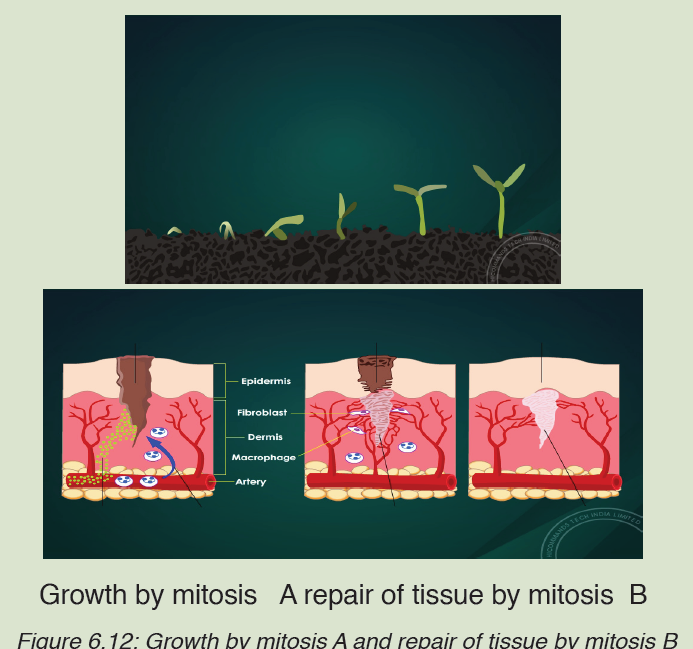
and differentiate into specialized cells of adult tissues and organs. As cells
differentiate from time to time, their rate of proliferation usually decreases.
As a result, most cells in adult animals are arrested at the G0 stage.
Some cells at this phase may resume the cell cycle and proliferate when
they receive certain signals. Some of the differentiated cells enter the Go
resting phase and wait for the signal to resume the cell cycle to repair injured
tissue. There are numerous examples such as skin fibroblast, endothelial
cells, smooth muscle cells, and liver cells. Skin fibroblasts upon receiving
growth factor, skin fibroblast start secreting collagen and help in repairing
cuts or wounds. Most of the fully differentiated cells no longer possess the
capability of cell division. Therefore, they can be replaced by stem cells.
Stem cells are undifferentiated biological cells that can differentiate into
specialized cells and can divide (through mitosis) to produce more stem cells.
The prominent role of stem cells can be seen in—blood cells (hematopoietic system), epithelial cells of the skin, and epithelial cells lining the digestive
tract. All of these cells have short life spans, and they must be replaced
continually by continual cell proliferation in adult animals, which is done by
mitosis.
The life span of blood cells ranges from less than one day to a few months.
All of these cells are derived from the same population of hematopoietic
stem cells. In fact, there are more than 100 billion blood cells that are lost
every day in humans. If there are no stem cells to replace the loss of
these cells, human beings will not be able to survive. Hence, these cells
are continually being replaced by cells produced from hematopoietic stem
cells in the bone marrow by means of mitotic division. Meiosis is necessary
in gametes formation, and this helps organisms to multiply by reproduction.
The Significance of Mitosis in Cell Replacement and Tissue Repair by
Stem Cells
a) Mitosis allows growth: A single cell divides repetitively to produce
all the cells in an adult organism.
b) Mitosis allows to repairing and cell replacement: by producing
new cells to replace ones that have been damaged or worn out.
c) Mitosis is involved in asexual reproduction: a single parent celldivides into two genetically identical offspring.
d) Mitosis allows geneticstability by producing two nuclei which have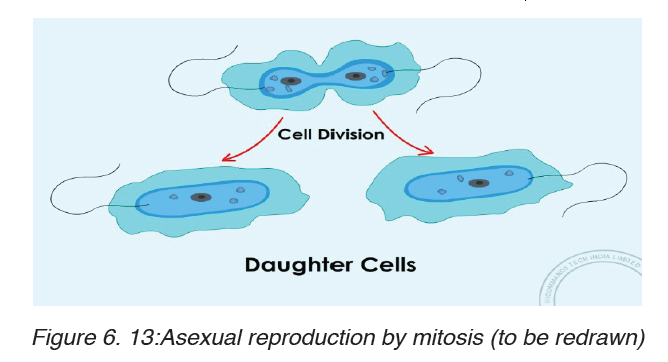
the same number of chromosomes as the parent cell.
e) Regeneration: Some animals are able to regenerate whole parts of
the body, such as legs in crustacean and arms in starfish. Production
of the new cells involves mitosis.
Regulation of the cell cycle
Regulation of the cell cycle helps the living organism to live healthily. The
cell divides by mitosis only when required. When receives signals from
neighboring cells, it responds by dividing or not dividing. The most known
cell cycle regulators include proteins called cyclins, the proteins which
regulate the timing of the cell cycle in eukaryotic cells. There two types of
regulators proteins such as internal regulators, and external regulators
which include growth factors.
Many cancers result from uncontrolled cell division, when the regulation of
the cycle is lost. Cancerous cells divide much more rapidly than healthy
cells. These cells use the blood and nutrients that other cells need and they
can stress the environment of the healthy cells. As cancerous cells do not
provide any useful function to the organism, they are extremely harmful. If
cancerous cells are allowed to grow uncontrolled, they will kill the host
organism.Cancer and uncontrolled cell division
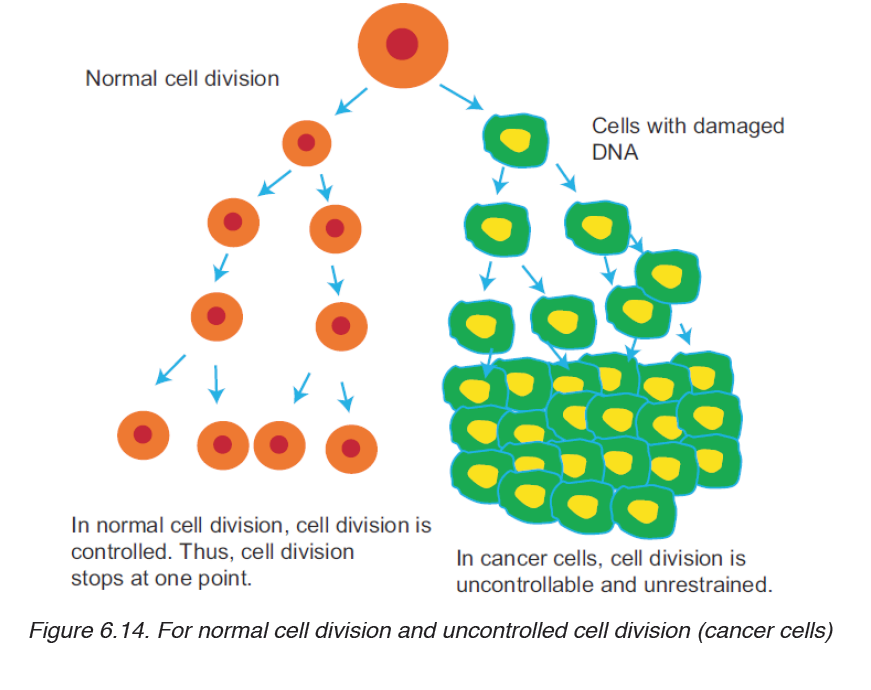
The problem begins when a single cell in a tissue undergoes transformation,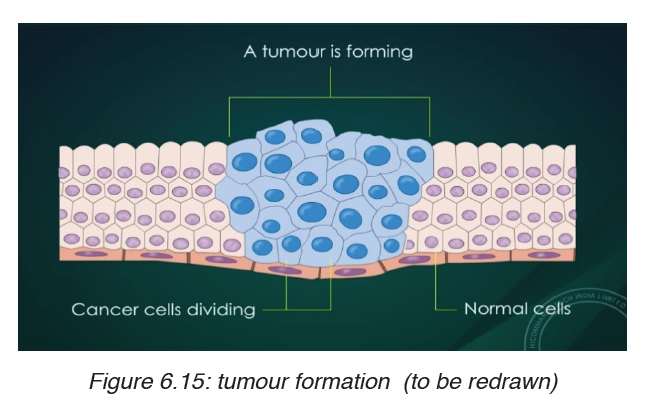
the process that converts a normal cell to a cancer cell. The body’s immune
system normally recognizes a transformed cell asan abnormal and destroys it.
However, if the cell escapes immune system, it may proliferate to form atumor
(a mass of abnormal cells within an otherwise normal tissue). There are
three types of tumors: benign tumors, malignant tumors and metastasis.
i. Benign tumour: it is a lump of the abnormal cells that remains at the
original site. Most benign tumors do not cause serious problems and
can be removed by surgery.
ii. Malignant tumors: these are cells abnormal cells that have become
invasive enough to impair with the functions of one or more organs. An
individual with a malignant tumor is said to have cancer.
iii. Metastasis: Cancer cells may also separate from the original tumor,
enter the blood and lymph vessels, and invade other parts of the body,
where they proliferate to form more tumors. This spread of cancer cells
beyond their original site is called metastasis.
Many cancers can be inherited, such as breast cancer, others are triggered
by viral infections, tobacco smoke (e.g. lung cancer) and radiations (e.g.
skin cancer). All cancers have one thing in common: the control over the cell
cycle has broken down.
Significance of Meiosis
a) The need for reduction prior to fertilization in sexual reproduction
Generally, a cycle of reproduction consists of meiosis and fertilization. Before
sexual reproduction occurs, gametes undergo meiosis and produce haploidcells. Thus during sexual reproduction, one haploid (1n) gamete comes from the paternal side and another haploid (1n) gamete comes from the maternal side; then, they both fuse to form a zygote, which is diploid (2n). The fusion
of gametes to form zygote or new cell is called as fertilization or syngamy. If meiosis does not occur before sexual reproduction, the chromosome number would double up with each fertilization. And after few generations,
the number of chromosomes in each cell would become impossibly large.
For example in humans, in just 10 generations, the 46 chromosomes would
increase to about 47104 (46 × 210).
b) Role and Significance of Meiosis in Producing Gametes
Gametogenesis is a biological process by which diploid cells undergo cell
division and differentiation to form mature haploid gametes. It occurs through
meiosis. In humans, the male gamete (sperm) is produced by a process
called spermatogenesis and the female gamete (egg) is produced by a
process called oogenesis through meiotic division. Here gametes function
takes place soon after meiosis but in plants it happens after gametophyte
formation sexual reproduction of plants starts with spore formation.
Sporophyte is a diploids generation of flowering plant where haploid spores
are produced by meiosis which in turns undergoes mitosis to form multicelled
haploid gametophytes. These haploid gametophytes differentiate to
produce gametes—sperm and egg cells. Similarly, embryo sac is formed
by reduction division. Each of the cells of embryo sac is haploid. Two of the
nuclei fuse to produce diploid nucleus.
c) The Role of Meiosis in Reproduction of Plants
Generally, plants reproducing sexually have life cycle consisting of two
phases
– A multicellular gametophyte or haploid stage:
– It is a haploid stage with n chromosomes. It alternates with a multicellular
sporophyte stage.
– A multicellular sporophyte or diploid stage:
It is a diploid stage with 2n chromosomes, made up of n pairs. A mature
sporophyte produces spores by meiosis, a process which reduces the
number of chromosomes from 2n to 1n.
Alternation of generations (also known as mutagenesis) refers to the
occurrence in the plant life cycle of both a multicellular diploid organism
(sporophyte) and a multicellular haploid organism (gametophyte), each giving
rise to the other. This is in contrast to animals, in which the only multicellular
phase is the diploid organism (such as the human man or woman), whereas
the haploid phase is a single egg or sperm cell. In bryophytes (mosses and liverworts), the dominant generation is haploid, so that the gametophyte
comprises the main plant. On the contrary, in tracheophytes (vascular
plants), the diploid generation is dominant and the sporophyte comprises
the main plant.
d) Independent Assortment of Chromosomes
Specifically at metaphase I, each homologous pair of chromosomes
positioned independently of the other pairs. As a result, each homologous
pair sorts out its maternal and paternal homologue into daughter cells
independently of every other pair. This act of separating homologous pairs
independently is called independent assortment. The random orientation
of homologous pairs of chromosomes due to independent assortment in
meiosis I (metaphase) increases genetic variation in organisms.
e) Crossing Over and Random Fertilization
During crossing over, DNA segments of the two parents-paternal and
maternal are combined into a single chromosome producing recombinant
chromosomes, which are non-identical with their sister chromatids.
In humans, an average of one to three crossing over events occurs per
chromosome pair, depending on the position of their centromeres and on
the size of the chromosome. Thus, crossing over is an important event of
meiosis that brings genetic variation in sexual life cycles.
Besides independent assortment and crossing over, the random fertilization
during sexual reproduction also increases genetic variation in organisms.
During random fertilization, the male gamete and female gamete fuse to
form zygote. The most interesting thing is that this zygote has the possibility
of about 70 trillion diploid combinations. The number 70 trillion comes from
possible combinations of male and female gametes which are 223 × 223 = 70
trillion. The possibility of this enormous number of combinations makes each
and every one of us unique physically and genetically.
f) Non-disjunction of Chromosomes
Proper separation of chromosomes during meiosis is essential for the normal
growth in humans. Any set of chromosomes that do not separate properly
during meiosis results in improper separation of chromosomes or nondisjunction,
which is a serious issue in human genetics. Non-disjunction is
a condition in which the homologues or sister chromatids fail to separate
properly during meiosis. It can lead to the gain or loss of chromosome, a
condition called as aneuploidy. Example: Down syndrome is an autosomal
trisomy. It is also called as trisomy 21, where non-disjunction results in an
embryo with three copies of chromosome 21 instead of the usual two copies of chromosome 21. The origin of trisomy’s condition is through non-disjunction
of chromosome 21 during meiosis. Failure of paired homologues to separate
during either anaphase I or II may lead to gametes with 23 + 1 chromosome
composition instead of the normal 23 gamete chromosome composition.
Therefore, instead of 46 normal chromosomes, Down syndrome patient will
have 47 chromosomes with three copies of chromosome 21 instead of the
normal 2 copies. It was first discovered by John Langdon Down. The chance
of occurrence is one infant in every 800 live births.
The most common symptoms of Down syndrome or trisomy 21are:
– They are short.
– They may also have protruding, furrowed tongues, which causes the
mouth to remain partially open.
– They are mentally retarded.
– They have a prominent epicanthic fold in the corner of each eye; and
typical flat face and round head.
– Usually, there is a wide gap between the first and the second digits on
their feet
Organisms and the significance of cell division
a) Spindle fibres formation,
Spindle fibers are microtubules that move chromosomes during cell division.
They are found in eukaryotic cells. Spindle fibers moves chromosomes during
mitosis and meiosis to ensure that each daughter cell gets the correct number
of chromosomes. The spindle apparatus consists of spindle fibers, motor
proteins, chromosomes, and, in some cells, structures called asters (which
are star-shaped structures form around each pair of centrioles during mitosis.
They help to manipulate chromosomes during cell division to ensure that
each daughter cell has the appropriate complement of chromosomes). In
animal cells, spindle fibers are produced from cylindrical microtubules called
centrioles. Centrioles are separated by asters to generate spindle fibers
during the cell cycle. Centrioles are located in a region of the cell known as
the centrosome.
Synapsis
In prophase I, homologous chromosomes become closely associated in
synapsis. Synapsis includes the formation of an elaborate structure called
the synaptonemal complex, consisting of homologous chromosomes
paired closely along a lattice or zipper-like structure of proteins between
them. The components of synaptonemal complex include a meiosis-specific form of cohesin that helps the two homologous chromosomes to be closely
associated along their length.
Some events that occur along with synapsis are:
– The nuclear envelope breaks down.
– Two pairs of centrosome migrate to opposite poles.
– Spindle fibres formation occurs.
Bivalents
These arethe two homologous chromosomes attached at chiasmata. The
homologous chromosomes consist of two sister chromatids each.
Chiasma formation and movement of chromosomes
Chiasmata is the region of crossing over between two homologous
chromosomes during prophase I of meiosis. At the chiasmata, homologous
chromosomes exchange genes, allowing genetic information from both the
paternal and maternal chromatids to be exchanged, and a recombination
of paternal and maternal genes can be passed down to the progeny. Thisprocess is important in diploid organisms to ensure variation in the progeny.
Process of chiasmata formation.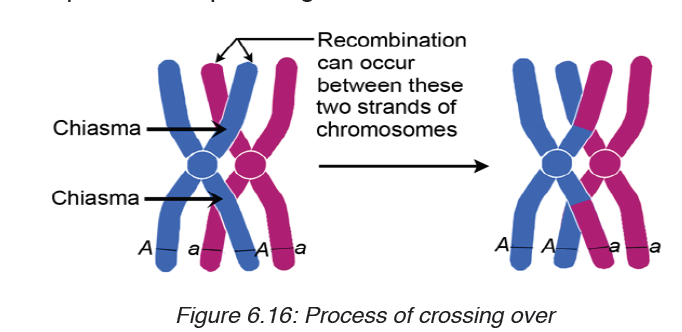
At prophase I of meiosis, after the homologous pair of chromosomes pair up
in the process called synapsis, the non-sister chromatids overlap, forming an
X-shape. They then exchange their alleles at the point of crossing over. The
X-shape the homologous pair together until the cell progresses to anaphase.
Movement of chromosomes.
In early Prophase I, chromosomes change their size and become short and
thick. This is the first movement they make during meiosis
In late Prophase I, homologous chromosomes become fully shortened and
thickened lie side by side (in a process called synapsis).
In metaphase I, Pairs of homologous chromosomes migrate to the equatorial
plane of the cell.
Each chromosome moves independently of all the others and the phenomenon
is called independent assortment.
During anaphase I, the homologous chromosomes separate and begin to
move to the opposite poles of the cell, pulled by the shrinking spindle fibers.
In telophase I, the movement of the homologous chromosomes to the poles
is completed.
During Prophase II chromosomes again become thicker and shorterbegin
to move to the equatorial plane of the cell. Spindle fibers once again begin
to form at the poles.
During metaphase II the chromosomes become aligned on the equatorial
plane and spindle fibers attach to the centromeres.
In anaphase II, the centromeres divide, separating the sister chromatids,
that move to the opposite poles due to the spindle fibers pulling.
In telophase II, the movement of the chromosomes to the poles is completed
and the spindle disappears
Application activity 6.3
1. Discuss possible functions of mitosis in living organisms.
2. Appreciate the role of cyclins in the process of cell cycle.
3. Describe the three types of tumors.
4. Descried the process of tumor formation.
SKILLS LAB
Cell division is essential biological process that contributes to growth and
reproduction that help in well being of all living organisms. Due to this
knowledge of cell division, student-teachers will use different techniques
out of school to make the food producing plants growing rapidly by providingthem food substances increasing the rapid cell division.
End unit assessment 6
I. Choose whether the following statements are True (T) or False (F)
1. A typical cell spends most of its time in interphase.
2. Mitosis is a process where a single cell divides into three identical
daughter cells.
3. Cytokinesis is a division of cytoplasm.
4. The process of mitosis is basically divided into 5 phases.
5. Meiosis is divided into three stages: Meiosis I, Meiosis II and Meiosis III.
6. The unrestrained, uncontrolled growth of cells in human beings results
into a disease called cancer.
7. Cancer occurs due to failure in controlling cell division.
8. Proper separation of chromosomes during meiosis is not essential for
the normal growth in humans.
9. The life span of blood cells ranges from less than one day to a few
months.
II. Multiple Choice Questions
1. In telophase, the nuclear envelope re-forms around the........... set of
haploid daughter chromosomes.
(a) one (b) two (c) three (d) four
2. ............................... is a condition in which the homologues or sister
chromatids fail to separate properly during meiosis.
(a) Disjunction (b) Non-disjunction (c) Down syndrome (d) None of these
3. Which of the event is correct in anaphase
a) Sister chromatids separate and give rise to daughter chromosomes.
b) Chromosomes are aligned at metaphase plate.
c) Cytokinesis starts occurring.
d) Chromosomes begin to uncoil.
4. One round of oogenesis produces
(a) One egg (b) Two eggs (c) Three eggs (d) Four eggs
5. In mitosis, which of the following occurs?
(a) Chiasmata formation (b) DNA replication(c) Synapsis (d) None of these
III. Long Answer Type Questions
1. Describe the main stages of cell cycle.
2. In your own words, explain what is meant by homologous pairs of
chromosomes.
3. In your own words, describe the process of mitosis.
4. In your own words, describe the process of meiosis.
5. Outline the significance of mitosis in cell replacement and tissue repair
by stem cells.
6. In your own words, explain how uncontrolled cell division can result in
the formation of a tumour.
7. What is the need for reduction prior to fertilization in sexual reproduction?
8. In your own words, explain the importance of effective cell division.
9. Outline the role of meiosis in gametogenesis in humans and in the
formation of pollen grain and embryo sacs in flowering plants.
10. Explain how crossing over and random assortment of homologous
chromosomes during meiosis and random fusion of gametes at
fertilization leads to genetic variation, including the expression of rare
recessive alleles.11. Analyse the following diagram and answer the questions below
a) Identify the stage of cell division shown in the figure.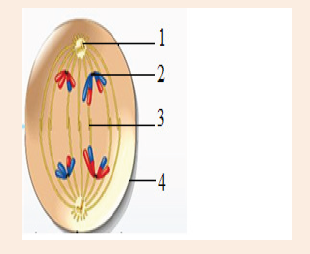
b) Label the structures marked as (1), (2), (3) and (4).
c) Which type of cell is involved in this division?
d) What will happen if the structure marked (3) is not formed?
12. How can you correlate the spread of HIV virus with the process of
Mitosis? Knowing the viral disease and its spread, discuss in brief thestigma and discrimination faced by those affected by HIV and AIDS.
